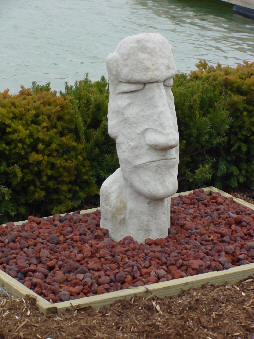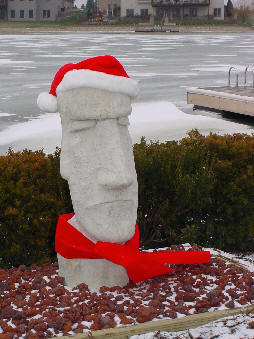|
A year ago this time, I was putting the final touches on a trip to do research for some upcoming writing projects. One of my South Pacific destinations was Easter Island (or Rapa Nui). I spent many an hour reviewing the newest material about Easter Island's nearly nine hundred moais that dot that small island. The moais are statues cut by the islanders from volcanic rock some of which date back a millennium. The birthplace of most all of the moais is Rano Raraku, which is a large and extinct volcano in the eastern portion of the island. The islanders would cut the moai in the horizontal position from the volcanic rock and then slide the statue on wooden rollers to the intended site. There is also a more interesting legend that contends that the moais actually walked from Rano Raraku to their intended location. Regardless of the manner of reaching their final destination, only one third of the moais made it. Once they arrived, they were placed on top of an ahu, which is a platform containing one or more moais. The ahus with the moais atop are placed approximately a half mile apart and encircle the island close to the coastline. All these moais face inland with their backs to the sea. The moais vary in height from 6 to 33 feet high and could weigh up to 80 tons. However, the mother of all moais never was completed and remains until today awaiting birth at Rano Raraku. It measures a massive 65 feet in length and tops the scales at an estimated 270 tons. They either ran out of wood to deliver it, or it didn't take its Wheaties. The moais fall into two groupings: those with long-ears and those with short-ears. The long-ears carvers conquered the short-ears carvers in a civil war. Having spent time on Easter Island, I can't imagine a tribal war taking place on that diminutive island battle ground. During my Christmas break from teaching, my wife and I managed to see nearly every one of the moais. Perhaps, that accounts for our moai withdraw syndrome after returning to the States. After returning home and moving into our new home, we had to get our moai fix. After deciding on a long-ear moai, I went about the arduous task of constructing the base for an ahu upon which our long eared moai would rest.
Our moai waiting for Christmas.... This article appeared in the Dixon Telegraph on 1/8/04.
|







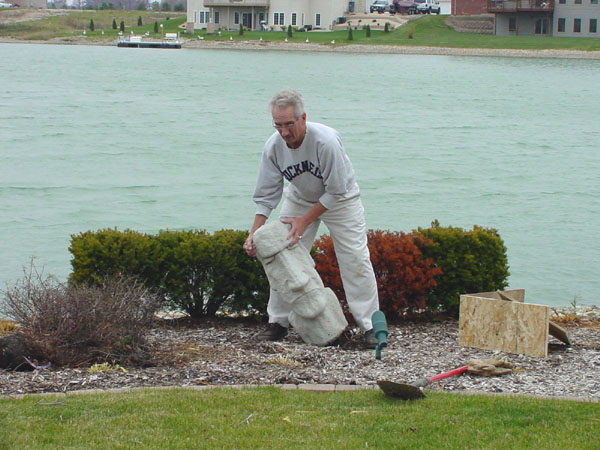 Then I drove all around northwest Indiana looking for just the right moai. At
first, we were looking for the short-eared variety with a topknot but settled
for the long-eared type-in part because we couldn't find the former style. We
affectionately named our moai, Maury. Maury the Moai stands a mere 4-foot high
and only weighs 150 pounds-a pale reflection of his more masculine archetypes.
Nevertheless, the transporting
Then I drove all around northwest Indiana looking for just the right moai. At
first, we were looking for the short-eared variety with a topknot but settled
for the long-eared type-in part because we couldn't find the former style. We
affectionately named our moai, Maury. Maury the Moai stands a mere 4-foot high
and only weighs 150 pounds-a pale reflection of his more masculine archetypes.
Nevertheless, the transporting
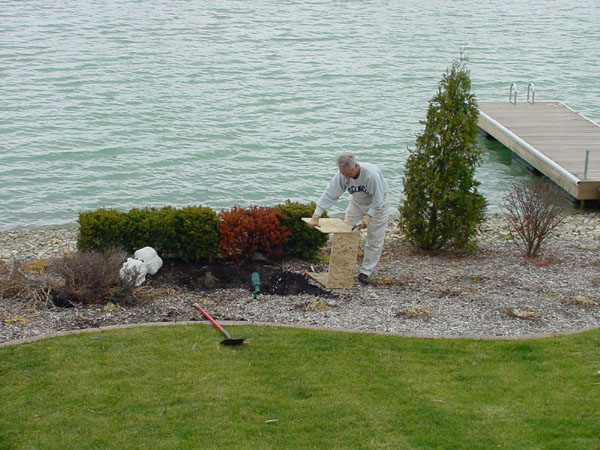 him down to the water's edge was not easy and
very time consuming. I wasted a lot of time once I got Maury out of my car
trying to coax him to walk down to our backyard by himself. However, Maury was
in one of those moai moods just like children who learned how to say, "No!" I
finally resorted to moving him on an appliance dolly. After placing him on his
pedestal, Maury seemed to get over his frump. He realized that I had
constructed a lovely ahu for him, and he seemed quite appreciative.
him down to the water's edge was not easy and
very time consuming. I wasted a lot of time once I got Maury out of my car
trying to coax him to walk down to our backyard by himself. However, Maury was
in one of those moai moods just like children who learned how to say, "No!" I
finally resorted to moving him on an appliance dolly. After placing him on his
pedestal, Maury seemed to get over his frump. He realized that I had
constructed a lovely ahu for him, and he seemed quite appreciative. 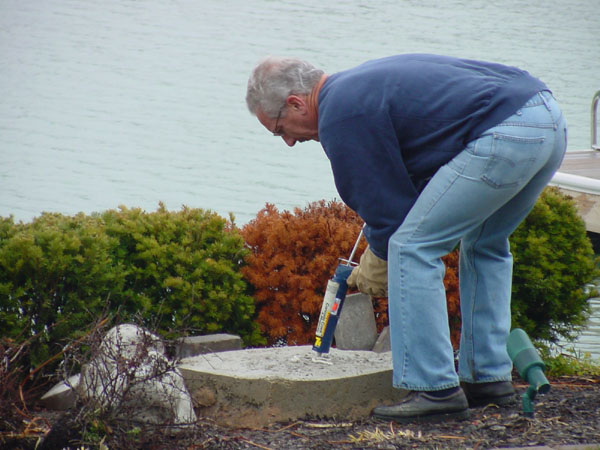
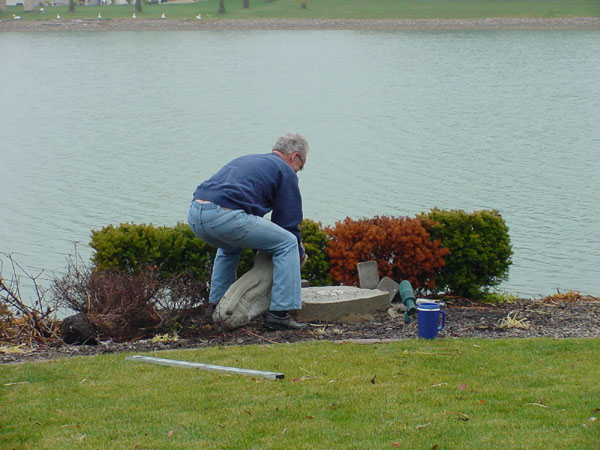
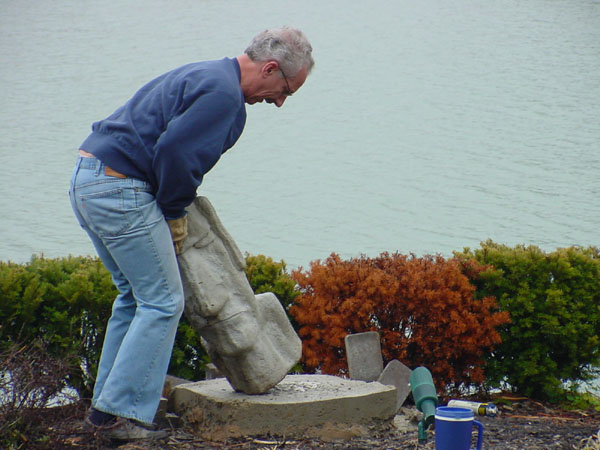
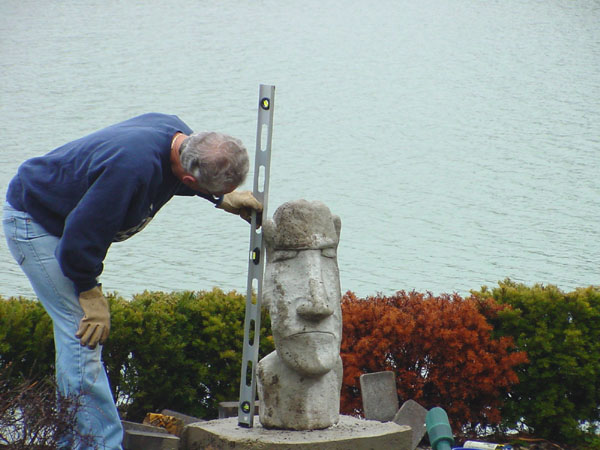
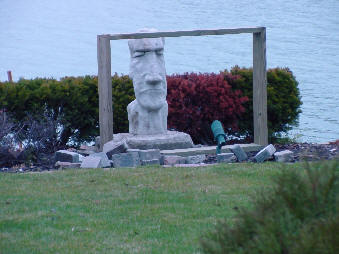 Having raised my moai to his perch on his ahu, I used concrete caulk to secure
him to the ahu. I didn't want him to blow over in a strong wind off the lake.
Then I went about completing his ahu. To make Maury Moai feel at home, I got
several bags of lava rock for his ahu. Once he saw the lava rock and the final
landscaping around the ahu, Maury settled down to his place in life and began
his task of protecting our home. Moais on Easter Island were thought to protect
and bless the
Having raised my moai to his perch on his ahu, I used concrete caulk to secure
him to the ahu. I didn't want him to blow over in a strong wind off the lake.
Then I went about completing his ahu. To make Maury Moai feel at home, I got
several bags of lava rock for his ahu. Once he saw the lava rock and the final
landscaping around the ahu, Maury settled down to his place in life and began
his task of protecting our home. Moais on Easter Island were thought to protect
and bless the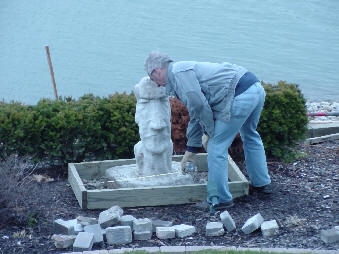 homes that they faced. He seems content now. Fortunately for us, Maury's installation is finally complete for the winds of winter are beginning
to blow against his back. Nevertheless, Maury seems quite content with his new
home and duties.
homes that they faced. He seems content now. Fortunately for us, Maury's installation is finally complete for the winds of winter are beginning
to blow against his back. Nevertheless, Maury seems quite content with his new
home and duties.